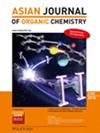Electron Push‐Pull Effects for Solution and Solid‐State Emission Control in Naphthalene 2,7‐Position‐Based Donor–Acceptor–Donor
IF 2.8
4区 化学
Q1 CHEMISTRY, ORGANIC
引用次数: 0
Abstract
Organic luminescent materials have garnered significant attention owing to their potential applications, particularly due to their inherent flexibility and ease of processability. Accordingly, the development of strategies that enable precise control over both intra‐ and intermolecular interactions, which directly influence their emission properties, is of paramount importance. In this study, a series of naphthalene (NAP) 2,7‐position‐based donor–acceptor–donor (D−A−D) compounds were designed and synthesized to investigate the electron push‐pull effect on intramolecular and intermolecular interactions. The energy bandgaps of the compounds were controlled by the electron push‐pull effect, resulting in red‐shifted emission within 48 nm in the order of increasing electron‐donating ability in solution state. Experimental data and theoretical calculations show that the intramolecular charge transfer (ICT) properties of D−A−D compounds are systematically controlled by electron push‐pull effects. In particular, the solid‐state emission of the compounds showed a redshift in the same order as that observed in solution. This solid‐state emission behavior is explained by the electron push‐pull effect‐dependent intermolecular interactions. Consequently, an efficient single‐molecule and multi‐molecule emission control strategy by electron push‐pull effect in NAP 2,7‐position‐based D−A−D was successfully demonstrated.

求助全文
约1分钟内获得全文
求助全文
来源期刊

Asian Journal of Organic Chemistry
CHEMISTRY, ORGANIC-
CiteScore
4.70
自引率
3.70%
发文量
372
期刊介绍:
Organic chemistry is the fundamental science that stands at the heart of chemistry, biology, and materials science. Research in these areas is vigorous and truly international, with three major regions making almost equal contributions: America, Europe and Asia. Asia now has its own top international organic chemistry journal—the Asian Journal of Organic Chemistry (AsianJOC)
The AsianJOC is designed to be a top-ranked international research journal and publishes primary research as well as critical secondary information from authors across the world. The journal covers organic chemistry in its entirety. Authors and readers come from academia, the chemical industry, and government laboratories.
 求助内容:
求助内容: 应助结果提醒方式:
应助结果提醒方式:


